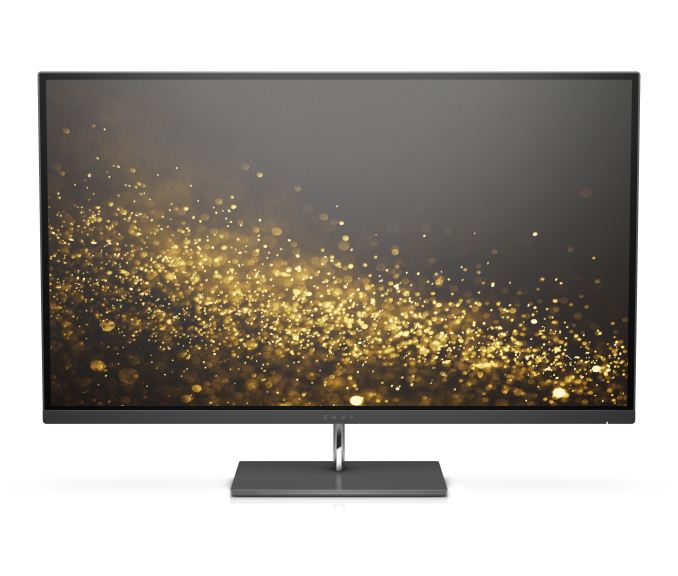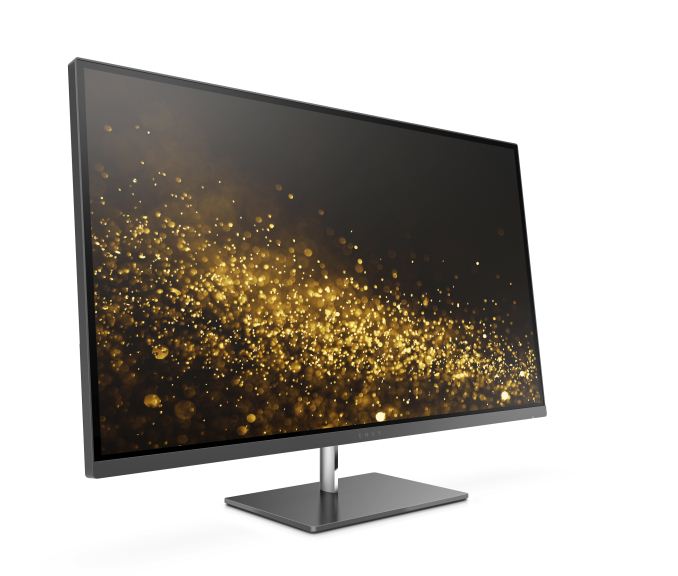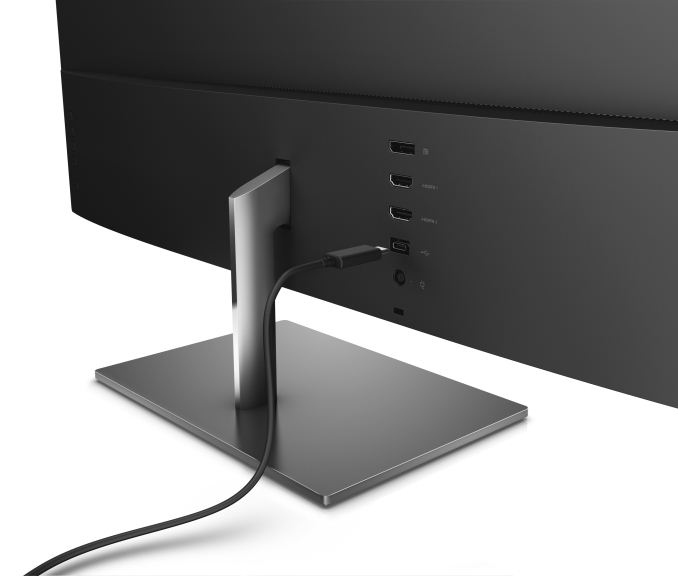HP Announces The HP ENVY 27 4K Thin Bezel Display
by Brett Howse on October 12, 2016 12:30 AM EST
Today HP announced an update to their product lineup, and one of the announcements that caught my eye immediately was the new ENVY 27 display. HP has packed a lot of features into a great looking display, but best of all it’s going to be available for $499.
The 27-inch display is an IPS panel, and although HP doesn’t list the refresh rate, it is likely going to be 60 Hz. It also supports FreeSync, meaning it should help with image tearing when gaming at 4K, where the high resolution really taxes even the strongest cards. The benefits won’t be as pronounced as some higher refresh rate gaming displays, but regardless it is better to have this than not.
HP is also promoting that the “sRGB color accuracy exceeds 99 percent” which sounds like they don’t mean what they are saying. Accuracy is generally measured in Delta E, where lower is better, and gamut coverage is measured in percentage. With full sRGB gamut coverage, hopefully they have spent a bit of effort on panel calibration, and if so they will have a pretty nice display for the money.
It also features DisplayPort, HDMI, and USB-C for connectivity, and the latter can also charge your laptop or phone with up to 60 Watts of power. That means this can be a single cable connection to drive the display and power the laptop, which is exactly what USB-C is designed to achieve, and it’s great to see more products supporting this. For a desktop, it is less important, but if you want to dock your laptop, a single cable will give you display, and power.
The design is a thin bezel, with a chrome finished support mounting the display to the base. There is no mention of height adjustment, and the images are unclear.
As already mentioned, this 27-inch 4K IPS FreeSync display will be price at just $499, with availability starting December 4th.
Source: HP via Windows Blog












37 Comments
View All Comments
BiggerInside - Friday, October 28, 2016 - link
HDR in film/video actually has more to do with expanded *brightness* (I.e. luminance) of the display. Think of a scene of snow and ice: on conventional displays, the brightest white is the max output of the display (as is the white background of this page), and everything else is darker to show texture/contrast. HDR assumes that there will be small areas of the screen (specular reflection of sunlight, for example, and even a few parts of he snow/ice you want to highlight to show texture) that will look more realistic if they are far brighter than anyone would ever reasonably make the background of a website. Obviously this needs new display tech (brighter backlights or OLED is part of it, but you also need enough data to fit the highlight range without losing shadow detail or seeing banding in saturated colors--so 10 bit is pretty much the minimum, where we can get usually get away with 6 bits for conventional displays and nobody notices.)"HDR" in digital photography is basically the opposite: fit super-bright highlights and detailed shadows within that~6bit luminance range of computer monitors and inkjet prints. If HDR displays are CD audio recordings of an orchestra playing music that goes from soft to very loud, then the photographer HDR stuff is like an AM radio broadcast of the same orchestra, where an engineer/device just cranks up the volume of the concert during the soft parts so you can hear it over the noise--but the loud parts never have the impact they originally did.
Xajel - Wednesday, October 12, 2016 - link
Yeah, I'm waiting for one, an HDR enabled 21:9 1440p @120~144Hz, and better with as high as AdobeRGB it can get ( without bumping the price too much )...Damn why There's no monitor with both FreeSync & G-Sync, Damn you NVIDIA... Hope VESA standarize FreeSync as a mandatory ( not optional like now ) with new DP version ( sadly this will take time )...
FreeSync is more common among displays duo to cheaper implementation, makers can easily add it to any monitor even cheap ones, and if rumors are true.. we will soon have FreeSync enabled TV's and Consoles using HDMI...
Valantar - Thursday, October 13, 2016 - link
That sounds like my dream monitor, pretty much. 34" (ish) 21:9 3440x1440 at at least 90Hz (I don't really care about more - the most important thing is that the minimum FreeSync refresh rate is as low as possible (40-ish or lower, please)), HDR, AdobeRGB or "Display P3" (with Windows somehow miraculously handling colour like it should), and individual colour calibration.I can't imagine Nvidia not enabling FreeSync support down the line (given that they already use it in laptops, just with eDP and under the name "mobile G-Sync"), but they're understandably reluctant due to the probably significant investment they've made into R&D and production of G-Sync hardware and software. Must have been a pretty big blow to the team working on it when AMD trotted out their essentially free, works-with-existing-controllers, open standard-based solution. I can't really imagine Nvidia making another generation of G-Sync controllers.
Valantar - Wednesday, October 12, 2016 - link
27-32" 1080p? Really? How far from the monitor do you sit? Windows at 100% scaling is meant to be 96 dpi - 1080p at 27" is 81, and at 32" is an abysmal 68. At 68 dpi, anyone with decent eyesight (not perfect, just not awful) will clearly see pixelation and aliasing at standard monitor viewing distances (~2-3 feet). Text would look absolutely awful. Not to mention that the UI would be HUGE. 2560x1440 at 32" is 91 dpi - tolerable at best.This is without mentioning that 96 dpi at 2 feet is far from ideal - it's more of a lowest common denominator in terms of looking ok no matter your eyesight. On the other hand, Windows scaling still needs to improve to allow for usability of higher DPI monitors for people with worse eyesight.
I'm with you on HDR, though. For me, 4k/UHD at normal monitor sizes (less than 30" 16:9, or 34" 21:9) makes little sense today - I'd rather have higher frame rates at an already okay pixel density at 2560x1440 (/3440x1440). And rendering 2560x1440 HDR will still be less computationally expensive than 4k non-HDR. I'm not saying that high DPI is meaningless on computer monitors - improved text clarity is not something to scoff at - just that (for gaming) it's too hard to run as of today, for very little percieved gain.
1080p outside of TVs and laptop screen sizes should just stop being a thing. Give us HDR, reasonable display densities, remove the meaningless added price for FreeSync, and we'd be golden.
Icehawk - Wednesday, October 12, 2016 - link
Huh? 27" 1080 monitors have been around forever and work fine. The UI is just right for me and it isn't excessively large. I have a 1440 as well and I had to scale the OS because everything was tiny. I keep thinking about getting a 32" 1440 which wouldn't require me to scale.Valantar - Wednesday, October 12, 2016 - link
That they've been around forever is not an argument for them being good. You might say the same for 20" 1600x900 monitors ...And sure, 1080p at 27" is passable. Just not good - even if the UI size is right for you, you can't argue against the pixel density being awfully low, causing pixelation and aliasing. Then again, that was the smallest of the display sizes mentioned, and the one I had the least issues with. My main issue was with the prospect of 32" 1080p panels. Too large to use comfortably at a desk (unless you mainly use the centre part of it) while having abysmally low dpi? Ugh.
1080p is good on a 50" TV because you sit 10+ feet away from it. At two-three feet, 1080p at anything above 27" would really start to lok bad.
Icehawk - Wednesday, October 12, 2016 - link
We can both agree on 32" 1080p being a terrible idea for any normal use of a monitor - although a few of the old ladies at my office would probably love it.Haawser - Wednesday, October 12, 2016 - link
'Meaningless added price for FreeSync' ?? Huh ? It's *G-Sync* that costs an arm and a leg.Valantar - Thursday, October 13, 2016 - link
There's still a price premium for FreeSync displays - just not as big of one as for G-Sync. Which is what makes absolutely zero sense - given that the hardware differences between a FS and non-FS display are practically zero. While I do get that there's a premium for higher refresh rates, a 60-75Hz FS display shouldn't cost substantially more than a similarly specced non-FS one. Given that you can implement FreeSync with off-the-shelf components and firmware, the price premium ought to be nearly zero - which it isn't. Hopefully this will happen soon. Making a PC display today without FS seems pointless to me.Meteor2 - Thursday, October 13, 2016 - link
Remind me, which DP standard is needed for HDR?Good to see USB-C being used properly.